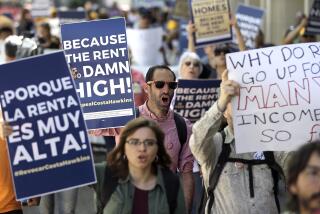Thousand Oaks Studies Ways to Curb Rental of Rooms in Homes
- Share via
Two years ago, after a Thousand Oaks homeowner served five days in County Jail for operating illegal rooming houses in neighborhoods zoned for single-family homes, he asked city officials exactly how many people he could rent to without going to jail.
“After the guy had done some time, he was very interested in complying with the law,” said Thousand Oaks Deputy City Atty. Shawn M. Mason. “But, in response, we had to say that the law really isn’t clear.”
The zoning laws in Thousand Oaks restrict the use of single-family homes, but a similar law in Santa Barbara was struck down in 1980 as being too vague.
So homeowner groups and Thousand Oaks are studying ways to limit what they say are the growing numbers of people who rent rooms in single-family homes. Residents pressing for a new city law regulating home rentals say that overcrowding in single-family homes creates parking and other problems.
Although no one knows exactly how many of the city’s 31,000 single-family homes are used as boarding houses, one city official estimates that about 20% of the estimated 1,500 to 2,500 complaints received by the city each year involve such living arrangements.
Way to Save Money
People rent rooms in single-family homes to save money and because of a shortage of affordable rental housing, city officials said. Most of the renters living in the homes are young, single people, officials said.
So far, constitutional questions have kept Thousand Oaks officials from enforcing all but the most blatant violations of zoning laws.
In 1980, the state Supreme Court struck down a Santa Barbara law requiring that single-family households of five or more people be related by blood, marriage or adoption. In that case, the court ruled that the law violated state constitutional provisions regarding the right of privacy.
The decision also invalidated zoning laws enacted in many cities, such as Thousand Oaks, that require households in neighborhoods zoned for single-family homes to be occupied by families because “there is no clear-cut definition of what a family is,” Mason said.
Prosecution of the landlord two years ago came under a provision of the city code forbidding the operation of boarding or rooming houses in single-family neighborhoods. The case was successful because the violation was so blatant, city officials said.
9-Bedroom Homes
The homeowner had illegally converted three three-bedroom homes, making them into nine-bedroom homes. As many as 20 people rented rooms on a weekly basis in each home, according to city records. Doors to bedrooms were numbered and equipped with locks, and each tenant had a rental agreement.
“We were able to convince a court that this was not being used as a single-family home because it looked like a hotel,” Mason said.
The man was given probation for breaking the city law prohibiting rooming houses in those neighborhoods and, when he later was caught continuing to operate one of the homes as a business, he was jailed for breaking the terms of his probation, Mason said.
But few of the cases investigated by city inspectors are as clear a violation of city laws, officials said. Only two landlords have been successfully prosecuted for operating boarding or rooming houses, according to city records.
“The majority of complaints under our existing law we can’t prosecute,” said Roy Beall, Thousand Oaks senior code enforcement officer.
‘Violations Tough to Prove’
Generally, the city is able only to prosecute landlords who illegally add bedrooms and kitchens to single-family homes or convert garages to living quarters, Beall said. “Rooming house violations are tough to prove in court,” he said.
The absence of city laws clearly regulating the rental of single-family homes prompted representatives of several homeowner associations to demand a meeting with city officials last summer.
Elois Zeanah, chairwoman of the League of Conejo Homeowners Assns., said the rental of single-family homes to large groups of tenants has created a variety of problems for neighbors, including traffic, noise, vandalism and blight.
“Our primary concern is the quality of life for families living in the residential areas of the city,” Zeanah said.
Since that meeting, the city’s Planning Commission has begun review of a proposal to limit the number of people living in a single-family home to two adults per bedroom in homes with two or fewer bedrooms, with a limit of one adult for each additional bedroom.
The proposed ordinance, which would apply only to homes in which five or more adults live, would be the first in the state and still needs more work, Mason said. For example, in a two-bedroom home “with a husband, a wife and three adult children, you could have a problem,” he said.
A Planning Commission subcommittee is studying the proposal to see if it warrants a public hearing before the City Council, Planning Commissioner Robert Lewis said.
“We will be also looking at restrictions tied to parking and existing building and safety codes that are consistent with the court cases,” he said.
Lewis and Planning Commissioner Chuck Vining, who form the subcommittee, said a final version of the ordinance will likely be ready for presentation to the City Council by early summer.
In the meantime, the city is continuing to encourage the construction of affordable apartments, City Councilman Frank Schillo said. The city has built about 500 apartments for low-income people in the last several years, he said.
“The only reason people are doing this is because they can’t find an apartment in town,” Schillo said. “The real solution is to provide more rental facilities for these people.”
More to Read
Sign up for Essential California
The most important California stories and recommendations in your inbox every morning.
You may occasionally receive promotional content from the Los Angeles Times.










